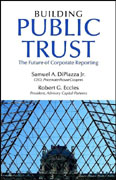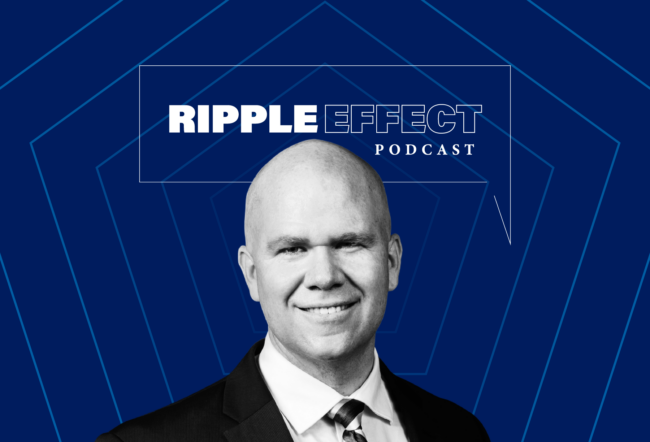Pity the poor CPAs who were ignored by society for so many years. While shows like “LA Law” made the legal profession look sexy and programs like “ER” gave physicians a larger-than-life presence, accountants rarely crossed the public’s mind.
Now, of course, CPAs are getting more coverage than ever before, although thanks to scandals at companies like Enron and WorldCom, it’s decidedly the wrong kind of press. In fact, as high profile former executives like Enron’s Michael J. Cooper and Andrew S. Fastow face the prospect of exchanging their pinstripe suits for black-and-white striped ones, some observers wonder if the accounting profession will ever regain the public’s trust.
In response to that issue, PricewaterhouseCoopers CEO Samuel A. DiPiazza Jr. and Robert G. Eccles, president of an advisory services company and senior fellow at PwC, have written a book called Building Public Trust: The Future of Corporate Reporting. While it does not break much new ground, the book does an admirable job of tying together a number of topics that have challenged the accounting industry and providing a framework for financial reporting in the future. At 179 pages, it is not much longer than say, WorldCom’s annual report, but it is packed with thought-provoking information, opinions and examples.
A New Model for Corporate Reporting
Essentially, Building Public Trust details a model of corporate reporting that the authors believe will encourage corporate honesty while delivering financial information to investors and other users in a speedier manner – and in a format that will be easier to understand. The book is timely, considering that passage of the Sarbanes-Oxley bill has stiffened penalties for Enron-style and other kinds of corporate misreporting. In addition, the SEC, despite the resignation of chairman Harvey Pitt, still plans to establish an accounting oversight committee to better regulate the accounting profession. Pitt’s choice to head that committee, William Webster, resigned on Nov. 12 before formally taking office.
But instead of relying solely on outside regulation, the authors focus on improving what they call the “corporate reporting supply chain.” Financial reporting is at the base of this supply chain, which encompasses a wide range of people including: the company executives who prepare the financials; the corporate board of directors who approve them; the independent auditing firms that attest to the fairness of the statements; and analysts and others who distribute the information. The final links in the supply chain are investors and other stakeholders who act upon the information, and regulators who establish the roles and responsibilities of many of the supply chain’s players.
Transparency, or openness and understanding, appears to be at the heart of the authors’ corporate reporting supply chain. A model that promotes transparency is useful; one that does not is simply more of the same old reporting. To explain their new system, DiPiazza and Eccles utilize a three-tiered model with Global Generally Accepted Accounting Principles (Global GAAP) as the base, followed by Industry-based Standards as the second tier, and topped off by company-specific information. As an adjacent concept, the authors suggest discarding the traditional paper-based format and instead delivering the information through an Internet-enabled platform called Extensible Business Reporting Language (XBRL).
By placing Global GAAP at the base of the new reporting model, the authors acknowledge the importance of being able to compare business results regardless of where a company is located. As barriers to international trade continue to get knocked down (through efforts that include the North American Free Trade Agreement and establishment of the European Union), and cross-border capital flows more freely, investors and others want reliable standards that share common metrics. In contrast, as DiPiazza and Eccles note, public capital markets today may use local GAAP, or principles based on national or international standards. Further, “the quality of these standards varies widely…as does how well they are applied…”
Will Global GAAP Help?
The authors admit, however, that achieving the globalization of GAAP will be a complicated task, especially since fundamental philosophical differences exist between U.S. and European standards. For example, while U.S. GAAP is based on rules and specific details, International Financial Reporting Standards tend to be more broadly based on principles. However, American organizations, including the Financial Accounting Standards Board (FASB), have made public commitments to reach agreement with European standard setters (Will Global GAAP Help?
The authors admit, however, that achieving the globalization of GAAP will be a complicated task, especially since fundamental philosophical differences exist between U.S. and European standards. For example, while U.S. GAAP is based on rules and specific details, International Financial Reporting Standards tend to be more broadly based on principles. However, American organizations including the Financial Accounting Standards Board (FASB) have made public commitments to reach agreement with European standard setters (the International Accounting Standards Board, or IASB), and at this point — despite some well-publicized spats between the FASB and the IASB — it is generally recognized that convergence of standards is a matter of “when,” not “if.” and at this point it is generally recognized that convergence of standards is a matter of ‘when,’ not ‘if.’
Although the first tier discussed in Building Public Trust involves establishing broad-based accounting principles, the second tier focuses on a somewhat narrower topic – accounting standards tailored by industry. As the authors point out, the Global GAAP advocated at the Tier One level will provide general compatibility among companies regardless of industry or location, but stakeholders “also need reliable and useful information on a company’s overall performance and prospects within its own industry.”
Such comparative financial and non-financial information – including the measurement of such key value drivers as intellectual capital, customer churn rate and other metrics – would make it easier to compare the performance of, for example, German and Japanese car manufacturers, or U.S. and British pharmaceutical companies. DiPiazza and Eccles say that this information is currently not readily available in GAAP-driven financial statements, although they note that “certain companies already report a small amount of this information.”
Their point is well taken, and indeed, the FASB has launched at least two projects (the Business Reporting Research Project and Disclosure About Intangible Assets) designed to address this gap. However, the authors believe that these “Tier Two” standards should be developed by industry participants, including accounting firms, analysts and investors (but apparently not by the SEC, FASB or other regulatory bodies), and add that such standards should be voluntary. In the authors’ view, as these standards are developed, “de facto standard setters will join the supply chain as well and may end up getting the support of market regulators.”
Initially, the argument that industry standards should not be developed by regulatory bodies does not sound very convincing, especially when those bodies appear to already be tackling the issue. Further, in the post-Enron era, investors and others may not be comfortable with reporting standards that are developed largely by the industries that are themselves subjects of the reports.
Some observers might point to pro-forma reporting (financial statements that have one or more assumptions or hypothetical conditions built into the data), which up until now has been largely industry-developed, as an example of the possible pitfalls of a laissez-faire approach to reporting. For example, in December 2001, the SEC was concerned enough to issue a document titled “Cautionary Advice Regarding the Use of ‘Pro Forma’ Financial Information in Earnings Releases.” At one time, companies used pro-forma as a way to eliminate distortions from unusual events, such as an acquisition. But now, an increasing number of companies use to it to dress up operating earnings by excluding inventory write-downs and other expenses, or by improperly including one-time gains.
DiPiazza and Eccles, though, point to the SEC document as evidence that self-developed standards can work, noting that the SEC advisory encouraged public companies to “consider and follow” pro-forma guidelines jointly developed by two industry groups, Financial Executives International and the National Investors Relations Institute. The authors also cite government-corporate collaboration, such as the Danish Agency for Trade and Industry, which worked with companies to develop guidelines for intellectual capital statements, and international collaboration undertaken by the Global Reporting Initiative, which encourages companies to report on economic, environmental and social activities.
“The leadership of a few companies will eventually gather up other companies in an industry,” predict the authors. “There will be diehards of course – companies that refuse to report according to Tier Two standards – but economic forces and the consequences of lost public trust will separate the winners from the rest.”
Awareness of the third tier, developing and communicating company-specific information, is also a key factor in success, according to DiPiazza and Eccles. “Internal information about the real value drivers of a company serves as the basis both for effective management and for appropriately transparent financial reporting,” they note, adding that stakeholders also need access to key performance measures. But corporate reporting, in its current format, generally does not provide the disclosure outlined in the authors’ Three-Tier model of transparency or the information requirements of the latter two tiers.
Instead, say DiPiazza and Eccles, management should consider a “Value Reporting Framework” (developed by PwC) that discloses four basic categories of information: Market Overview, Value Strategy, Managing for Value and Value Platform.
· The Market Overview would present the company’s assessment of the competitive and regulatory environment in which it operates. Noranda Canada, a mining company, accomplishes this by disclosing data about global production and consumption, as well as a sensitivity analysis that shows the annualized impact that a change in metals prices will have on the company’s earnings.
· The Value Strategy section would communicate the company’s quantitative and qualitative goals, the organizational structure to achieve those goals, and the governance function that would oversee management’s activities. The Royal Dutch/Shell Group of Companies uses such a report to describe its sustainable development activities and to explain how those activities will create value in future periods.
· The section headed Managing for Value links strategy and the company’s financial performance, focusing on such topics as business segments, the relationship between risk and return, and the ability of the company to generate cash. As an example, the authors cite a British retailer, The Boots Company, which ranks its performance (using a measure of shareholder value and group performance called Total Shareholder Return) against 10 peer companies on a rolling five-year basis.
· The Value Platform segment focuses on the financial and nonfinancial activities and relationships that underpin the way the company creates value. This would include measures of such intangibles as corporate reputation and product development processes that are today rarely considered. The authors note that the annual report of a Denmark-based medical company, Coloplast Group, reports detailed information (for a five-year period) on its value drivers, including working conditions and knowledge management, as measured by employee satisfaction, staff turnover and absence, and other metrics.
DiPiazza and Eccles say, however, that adoption of their three-tiered corporate reporting model does not close the book on accounting reform. Two additional issues need to be addressed: the way the information is delivered, and the way it is audited.
The authors believe that paper-based reporting formats should be replaced by Extensible Business Reporting Language (XBRL), which can be easily downloaded to a spreadsheet, enabling analytical and other functions to be accomplished faster, with less chance of transcription or other clerical errors. They also note that XBRL, which is being developed by a variety of companies, can speed the transfer of selected information inside and outside of a company. While Microsoft’s web site is considered to be the leader in its use of XBRL, the authors report that Morgan Stanley, Reuters and other companies are also publishing information in the XBRL format. But as Building Public Trust notes, “XBRL is only as good as the quality of information on which it is based.” And as a final topic, the authors look at the future of audits.
In the wake of Enron and other scandals, independent auditing firms must address the questions raised about the quality and relevance of their work. For DiPiazza and Eccles, one way to reassure the public is to give investors access to information that is more reliable, in a more timely fashion. In such an environment, they say, markets may begin to reward companies that “swiftly, fully, and accurately describe their performance,” which they believe will reduce incentives to manipulate earnings.
For example, the current format of an audit opinion (which generally summarizes what the independent auditor examined, and notes whether or not the auditor agrees that the financial statements were fairly presented), extends only limited comfort to investors and other stakeholders. DiPiazza and Eccles believe that in the future, the issues addressed in the audit opinion should be expanded, perhaps to include issues like management estimates, the possibility of fraud, and risks and future liquidity. Similarly, opinions could be developed to address audit opinions to cover Tier Two and Three engagements.
Readers who thrive on scandals or – tell-all revelations – won’t find those in this book, but then again, the authors did not set out to write a thriller. Instead, they have set out on a much more ambitious quest: an attempt to provide suggestions (or at least to spark a debate) on how to save an industry from itself. DiPiazza and Eccles may not have all the answers to accounting’s ills, but they appear to have done a good job of examining the relevant issues and offering a degree of confidence regarding their validity. And that, one might say, is what auditing is all about.



